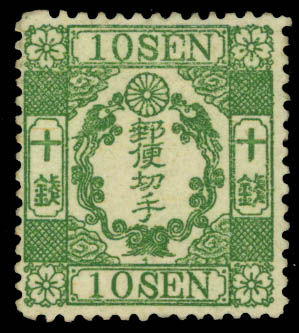 Among the most interesting issues in philately are the classic first issues of Japan called the Dragons. Japan was a closed society for about three hundred years before 1854. Japanese leaders had made the decision that they wanted no contact with outsiders (as they saw what foreigners were doing to China), and the penalty for attempting to enter Japan could be death. Admiral Perry forcibly "opened " Japan (primarily to obtain a new trading partner for American goods), and Japanese leaders soon realized that their feudal social structure needed rapid modernization if the the Japanese were to compete in the modern world. Feudalism ended with the Meiji Restoration in 1868 (Meiji was the Emperor whose name was placed on the internal coup which ended the feudal military government that was called the Tokugawa Shogunate). And Japan modernized quickly. In 1871 Japan issued its first postage stamps, very nicely locally engraved stamps on fine native paper. These stamps have always been scarce but are far less popular than they deserve because collectors fear the large number of forgeries that exist. Japan was a popular tourist destination for Americans and Europeans in the late Nineteenth Century, and one of the more popular souvenirs were small collections of postage stamps that tourists brought home. Because the first Japanese issues were so scarce, printers made many imitations and sold them to collectors. For collectors with familiarity with these issues, the imitations pose no threat, but many general collectors are afraid of any stamps that have been forged, and so prices of these issues are much lower than they would be otherwise.
Among the most interesting issues in philately are the classic first issues of Japan called the Dragons. Japan was a closed society for about three hundred years before 1854. Japanese leaders had made the decision that they wanted no contact with outsiders (as they saw what foreigners were doing to China), and the penalty for attempting to enter Japan could be death. Admiral Perry forcibly "opened " Japan (primarily to obtain a new trading partner for American goods), and Japanese leaders soon realized that their feudal social structure needed rapid modernization if the the Japanese were to compete in the modern world. Feudalism ended with the Meiji Restoration in 1868 (Meiji was the Emperor whose name was placed on the internal coup which ended the feudal military government that was called the Tokugawa Shogunate). And Japan modernized quickly. In 1871 Japan issued its first postage stamps, very nicely locally engraved stamps on fine native paper. These stamps have always been scarce but are far less popular than they deserve because collectors fear the large number of forgeries that exist. Japan was a popular tourist destination for Americans and Europeans in the late Nineteenth Century, and one of the more popular souvenirs were small collections of postage stamps that tourists brought home. Because the first Japanese issues were so scarce, printers made many imitations and sold them to collectors. For collectors with familiarity with these issues, the imitations pose no threat, but many general collectors are afraid of any stamps that have been forged, and so prices of these issues are much lower than they would be otherwise. Later issues of Japan are very popular too. The second and third issues (called Cherry Blossoms and Kobans respectively) are among the most specialized issues in our hobby, with collectors avidly seeking out perf. varieties and especially cancellations. Few non-Japanese speak (or read) Japanese; so many of these varieties are difficult to pick out from the Japanese language specialty catalogs. (American specialists of Japan would be wise to consult these catalogs for their collections.) Japan, which has a far older population than the United States, is beginning to see an influx of collectors, and the stamps of Japan are accordingly becoming more popular. Serious philately is more concentrated in retirement aged men, and Japan has far more people fitting this demographic than we do here in America. As a country to collect, Japan offers interest, beauty, specialization potential, and a large home market. There are few countries that offer more.
Later issues of Japan are very popular too. The second and third issues (called Cherry Blossoms and Kobans respectively) are among the most specialized issues in our hobby, with collectors avidly seeking out perf. varieties and especially cancellations. Few non-Japanese speak (or read) Japanese; so many of these varieties are difficult to pick out from the Japanese language specialty catalogs. (American specialists of Japan would be wise to consult these catalogs for their collections.) Japan, which has a far older population than the United States, is beginning to see an influx of collectors, and the stamps of Japan are accordingly becoming more popular. Serious philately is more concentrated in retirement aged men, and Japan has far more people fitting this demographic than we do here in America. As a country to collect, Japan offers interest, beauty, specialization potential, and a large home market. There are few countries that offer more.
